An Ode to the Futon
 Remember the futon? Old friend of college and first apartments, spring impaired with a frame easily dented by hard sitting (and often inebriated) big guys. Is it a bed? Is it a couch? It's both!
Remember the futon? Old friend of college and first apartments, spring impaired with a frame easily dented by hard sitting (and often inebriated) big guys. Is it a bed? Is it a couch? It's both!
Ah, the futon. Perenially underappreciated. It seems that the curb is invariably your destiny.
Stabbing bush
 We at kuaptic know from sharp plants, having stabbed ourselves more than once on resident kuaptic cactus, Kitty (quite a mouthful). She draws blood, by the way. But we were shocked on a recent walk to see that dead leaves drifting down had impaled themselves on a spikey plant. While the leaves are probably easily penetrable, we can't imagine that they fell with such force as to get stuck. Maybe there was a kid involved.
We at kuaptic know from sharp plants, having stabbed ourselves more than once on resident kuaptic cactus, Kitty (quite a mouthful). She draws blood, by the way. But we were shocked on a recent walk to see that dead leaves drifting down had impaled themselves on a spikey plant. While the leaves are probably easily penetrable, we can't imagine that they fell with such force as to get stuck. Maybe there was a kid involved.
The Leaning Couch of Palms
 Sometimes, especially having just fled a dark apartment, you just kind of have to lean on something. A lampost will do, or even a dumpster. You're out there, letting the world know that you could care less what they think. This couch thinks outside the box.
Sometimes, especially having just fled a dark apartment, you just kind of have to lean on something. A lampost will do, or even a dumpster. You're out there, letting the world know that you could care less what they think. This couch thinks outside the box.
Oh Palms!
 Seriously. Palms is so classy.
Seriously. Palms is so classy.
It's beginning to look a lot like Coachella
 The groundhog has surfaced and seen the first signs of the failing winter -- Coachella pre-sales are this week -- on the 25th, amid rumors of a Smashing Pumpkins reunion. It's just about this point in January, where you start to dream of desert winds (wait...don't we already have those?), endless sun, and long long twilights. Not to mention mindblowing sets by great bands.Ah Coachella...it looks like spring is here to stay!
The groundhog has surfaced and seen the first signs of the failing winter -- Coachella pre-sales are this week -- on the 25th, amid rumors of a Smashing Pumpkins reunion. It's just about this point in January, where you start to dream of desert winds (wait...don't we already have those?), endless sun, and long long twilights. Not to mention mindblowing sets by great bands.Ah Coachella...it looks like spring is here to stay!
Ambassador Falls

The Ambassador Hotel no longer exists (what you're looking at is the Coconut Grove, which will be turned into a theater in the new school.) Photo courtesy of
Franklin Avenue.
R.I.P.
Striped Couch
 A striped couch is a rare beast in Palms. It's seldom to see something not in ubiquitous beige -- though from time to time we get some paisleys or other flowered motif. It's got to be tough for a little striped guy. All the other couches make fun of him. Who knows? Perhaps his stripes will camoflage him better in the outdoors. Maybe he'll grow into his differences and lead Santa's sleigh!
A striped couch is a rare beast in Palms. It's seldom to see something not in ubiquitous beige -- though from time to time we get some paisleys or other flowered motif. It's got to be tough for a little striped guy. All the other couches make fun of him. Who knows? Perhaps his stripes will camoflage him better in the outdoors. Maybe he'll grow into his differences and lead Santa's sleigh!
Dahlia Noir
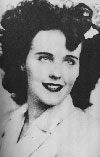 In Greek mythology, there is the story of a young girl named Persephone, daughter of the goddess of the harvest, who was stolen away by the king of the dead one fine spring day. She wandered alone through the vast grey gardens, and without thinking, she ate a few pomegranite seeds. Her mother, heartbroken, refused to let anything bloom until her daughter was returned to her. Hades laughed, because even though he had to let her go, Persephone had eaten the food of the dead. She must return to him for six months of the year. Though she could walk again in the sun, she would always be his.
In Greek mythology, there is the story of a young girl named Persephone, daughter of the goddess of the harvest, who was stolen away by the king of the dead one fine spring day. She wandered alone through the vast grey gardens, and without thinking, she ate a few pomegranite seeds. Her mother, heartbroken, refused to let anything bloom until her daughter was returned to her. Hades laughed, because even though he had to let her go, Persephone had eaten the food of the dead. She must return to him for six months of the year. Though she could walk again in the sun, she would always be his.
This archtypal story has been told for thousands of years. It could easily be the story of Elizabth Short, told slantways. Though she has died, she has fired the imaginations of so many that she lives on in a funny way -- as an icon, perhaps enduring longer than she would have had she lived. We don't mean to diminish of the suffering or the life of Beth Short, but when we still laud her beauty, and wonder at the circumstances of her death nearly sixty years later, we have to look at the deeper meaning. Why is she so enduring? Why her and not young heiress, Georgette Bauerdorfer, who died around the same time and whose case went unsolved? Or Jeanne French, whose death was often linked to the Dahlia case? Or countless others since?
The easy answers are that Beth is very beautiful, and the press picked up an excellent nickname for the case. But it also tapped into the dark side of Hollywood, and the Hollywood dream that very few cases do. A young girl comes west, full of dreams and finds only pain and death. It's a worst case scenario -- certainly much worse than many of those that exist today, not getting into the right clubs, not having your agent do anything for you, getting fired. What happened to the Black Dahlia exists on an entirely different plane than everyday life. Yet, we all know that Los Angeles, despite its endless sunshine, its lush foliage, and friendly grin, will gut you if it gets the chance, and never look back. This is why the Black Dahlia, in her own way, belongs to each and every one of us. She embodies those dark moments where you think you might not make it out alive.
Legacy
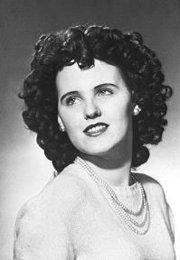 Like any legends, stories have grown up around Elizabeth Short -- and not just the kind in books. They say she was a hooker, a virgin physically unable to have sex, a loose woman who was "asking for it." She had an affair with Marilyn Monroe. She worked at the Hollywood Canteen (a place where actors and actresses showed their appreciation to soldiers by serving up free pie and coffee while chatting and dancing.) None of these stories are true. But many of them sprung from the attitudes of the time.
Like any legends, stories have grown up around Elizabeth Short -- and not just the kind in books. They say she was a hooker, a virgin physically unable to have sex, a loose woman who was "asking for it." She had an affair with Marilyn Monroe. She worked at the Hollywood Canteen (a place where actors and actresses showed their appreciation to soldiers by serving up free pie and coffee while chatting and dancing.) None of these stories are true. But many of them sprung from the attitudes of the time.
During the war, when Beth was coming of age, women were expected to be independent, to work, support their families, to hang around in bars, drinking and entertaining soldiers. they were finding their own way in the world. She grew up in a family supported only by her mother, and spent lots of time away from home in the winters in Florida. When she had troubles living with her father, she had no compunction about leaving him and finding a job. She knew she could find her own way in the world.
In 1947, the war had been over for two years, but culturally speaking, men were having trouble getting women back into the kitchen. They wanted their jobs and authority back. The family unit needed to be reinforced and the only way to do that were for women to go home. Having a beautiful young girl preyed upon, horrendously violated because she was vulnerable in the world served a cultural need. The papers reinforced this notion as the weeks progressed, calling the killer a werewolf, drawing attention to similar crimes -- independent young women, slain. Go home ladies, get a man to protect you.
Aftermath
 Over fifty people have confessed to killing the Black Dahlia. All of them have been checked out by the LAPD, and they concluded that none were guilty. Even now, people have all kinds of theories as to what happened and who did it. There's more than one person who feels their father did it. A childhood friend believes Orson Welles did her in, and another writer basically wrote a novel which has somehow become the authoritative text on the subject. One blames a doctor with a tangential relationship to Beth's sister. A curious website hashes it all out with some arcane numerology. James Ellroy wrote a mystery based on the case called The Black Dahlia, which is being made into a film.
Over fifty people have confessed to killing the Black Dahlia. All of them have been checked out by the LAPD, and they concluded that none were guilty. Even now, people have all kinds of theories as to what happened and who did it. There's more than one person who feels their father did it. A childhood friend believes Orson Welles did her in, and another writer basically wrote a novel which has somehow become the authoritative text on the subject. One blames a doctor with a tangential relationship to Beth's sister. A curious website hashes it all out with some arcane numerology. James Ellroy wrote a mystery based on the case called The Black Dahlia, which is being made into a film.
Most of these theories make interesting reads, though they tell you more about the writer than about Elizabeth Short herself. She gets a bit lost in the shuffle. But there's no denying that she's caught the imagination of thousands over the years. Would she have felt that her long and painful death was worth immortalization? It's doubtful. But that's why people come to LA, right? So you never know.
January 15, 1947
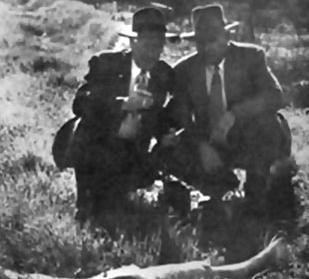 It was an early, cold January morning in the Leimert Park neighborhood of Los Angeles. Betty Bersinger took her infant son for a walk in his carriage. She was approaching the 3900 block of Norton Avenue, which was paved, but not yet built up. Grass was growing wild in the vacant lots. In the grass, Betty saw a white form -- like a manaquin, but in two halves, sprawled in the grass. She never got closer. She never thought it was anything other than a a dummy, but something about felt so wrong that instead of investigating, she turned heel, went to the nearest house to use their phone. She called the police.
It was an early, cold January morning in the Leimert Park neighborhood of Los Angeles. Betty Bersinger took her infant son for a walk in his carriage. She was approaching the 3900 block of Norton Avenue, which was paved, but not yet built up. Grass was growing wild in the vacant lots. In the grass, Betty saw a white form -- like a manaquin, but in two halves, sprawled in the grass. She never got closer. She never thought it was anything other than a a dummy, but something about felt so wrong that instead of investigating, she turned heel, went to the nearest house to use their phone. She called the police.
There's some question as to whether or the police or the reporters showed up first. However, there's no doubt of the horror they found there. She was naked. She had been bisected (some would say with medical precision) and cleaned, her body laid out in a very specific and lewd manner. She had chunks of flesh missing, but they think she died from the lascerations to her face -- incisions that went from the corners of her mouth up through the cheeks.
It was chaos at 39th and Norton. The crime scene was compromised by people tramping all over it. There were also some problems due to the rivalry between two different police factions. Though taunting notes in cut up newsprint were sent to the police, directing them to Beth's purse and other belongings, the case was never solved.
They did do something right though. Morgue techs collected her and sent her fingerprints through a primitive fax machine. Because she had worked at Camp Cook, they identified her by the end of the day.
Her name was Elizabeth Short.
Last Days
 Could she feel the walls closing in? Beth fled to San Diego on December 8th, 1946. Dorothy French, who found her asleep when she was closing her theater for the night. The girl took Beth to her home in Pacific Beach, where she lived with her mother. She stayed on, irritating Dorothy's mother by not looking for work and sleeping late. One night people pounded on the door. The family didn't answer at Beth's behest. A few days later, on January 9th, she beat it back to Los Angeles, getting a ride from a traveling salesman, Robert "Red" Manley, she'd been seeing in San Diego. She met him when he spoke to her from his car while she was standing on a street corner.
Could she feel the walls closing in? Beth fled to San Diego on December 8th, 1946. Dorothy French, who found her asleep when she was closing her theater for the night. The girl took Beth to her home in Pacific Beach, where she lived with her mother. She stayed on, irritating Dorothy's mother by not looking for work and sleeping late. One night people pounded on the door. The family didn't answer at Beth's behest. A few days later, on January 9th, she beat it back to Los Angeles, getting a ride from a traveling salesman, Robert "Red" Manley, she'd been seeing in San Diego. She met him when he spoke to her from his car while she was standing on a street corner.
He dropped her off at the Biltmore Hotel, downtown at seven pm. She claimed she was meeting her sister there and they would go up to Berkeley together. Beth hung around the bar for hours. Agitated, she made a number of phone calls. She left on foot, around 10pm, observed by the doorman, walking down Olive, and into Los Angeles history.
Enter the Dahlia
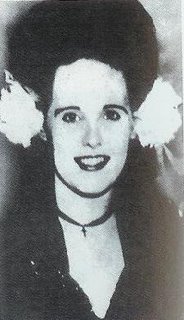 Beth was seeing a boy who worked at an airbase in Long Beach, another pilot. She was staying nearby. It was at a drug store soda fountain there that she earned the moniker, "The Black Dahlia" because of her penchant for wearing black. It was not a name she was called during her lifetime, rather something picked up by the papers later. The name comes from the movie The Blue Dahlia, a 1946 film starring Alan Ladd and Veronica Lake, where an ex-bomber pilot is accused of killing his adulterous wife.
Beth was seeing a boy who worked at an airbase in Long Beach, another pilot. She was staying nearby. It was at a drug store soda fountain there that she earned the moniker, "The Black Dahlia" because of her penchant for wearing black. It was not a name she was called during her lifetime, rather something picked up by the papers later. The name comes from the movie The Blue Dahlia, a 1946 film starring Alan Ladd and Veronica Lake, where an ex-bomber pilot is accused of killing his adulterous wife.
Beth was a mercurial girl, described as shining with warmth and sympathy, but quick to turn to distant ice. These highs and lows became part of her the character she played, bolstered by her natural beauty and unique style. For Beth, it must have seemed that she had wrought herself from nothing, a poor girl, without school smarts in Massachusetts to someone who might have walked out of a movie and into The Pig'n'Whistle or Steve Boardner's Bar. It's possible that her transformation was less deliberate than that. Perhaps it came from a dreamy place, something she could barely control. One moment she was a swan, but the next she was a phoenix, all light and fire, with no one close to give these changes any context.
Life was a dream and she drifted fitfully on its currents, unaware that her beauty and her solitude were part of heady mixture that would make her a legend.
Nothing says class
 ...like a toilet out front. Oh yes, Palms pulls out all the stops. It was especially inspired to put it in such a carefully manicured piece of landscaping. It's not even grassy, so it doesn't stand out in terms of size, but rather is nestled into some xeriscape-esque plants. DuChamps would be proud.
...like a toilet out front. Oh yes, Palms pulls out all the stops. It was especially inspired to put it in such a carefully manicured piece of landscaping. It's not even grassy, so it doesn't stand out in terms of size, but rather is nestled into some xeriscape-esque plants. DuChamps would be proud.
Out West
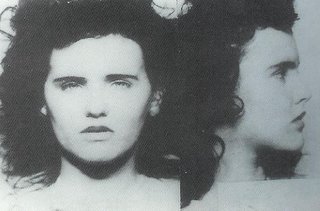 Life with her father was not like Betty (now calling herself Beth) thought it would be. She worked all day, as a cashier at Camp Cook (where was voted the "Camp Cook Cutie") and when she came home, her father expected her to clean and make him dinner. She didn't come out West to be locked up with an old man -- she'd come to see things, to have a good time. Eventually, he kicked her out for being lazy and staying out late. Then Beth was on her own. Eventually, she was picked up for underage drinking, and sent back to Medford. But one taste of California left Beth wanting more. She drifted back.
Life with her father was not like Betty (now calling herself Beth) thought it would be. She worked all day, as a cashier at Camp Cook (where was voted the "Camp Cook Cutie") and when she came home, her father expected her to clean and make him dinner. She didn't come out West to be locked up with an old man -- she'd come to see things, to have a good time. Eventually, he kicked her out for being lazy and staying out late. Then Beth was on her own. Eventually, she was picked up for underage drinking, and sent back to Medford. But one taste of California left Beth wanting more. She drifted back.
Not associating with her father, she lived life on the edge of poverty. She spent her days hanging out at soda fountains, hoping to be discovered, at night she worked as a bar or "b-girl," someone employed by bars to make men stay and buy more drinks. Though she did some small-time modelling, there's no proof that she ever made it to celluloid. She lived in apartments she shared with other girls in similar situations, or when nothing else was available, she would get a cheap hotel room.
Sunny Florida
 Betty spent a year in high school, but dropped out before long, an indifferent student. Because of her asthma, she spent winters in Florida, hanging around the beach and waitressing to support herself. It was in Miami that she met Major Matt Gordon, a young pilot and member of the Flying Tigers. There's some disagreement as to whether Matt and Betty became engaged (she certainly claimed they were. And he introduced her to his sister so they could begin a correspondence. He gave her a watch as an engagement gift.) She was in Medford when she heard that he had been killed on his way home from the war in the Pacific Theater in a telegram from Matt's mother. Curiously, Beth asked his family for some money so she could go out west and start a new life, a move that may seem scheming, but could have been made out of desperation.
Betty spent a year in high school, but dropped out before long, an indifferent student. Because of her asthma, she spent winters in Florida, hanging around the beach and waitressing to support herself. It was in Miami that she met Major Matt Gordon, a young pilot and member of the Flying Tigers. There's some disagreement as to whether Matt and Betty became engaged (she certainly claimed they were. And he introduced her to his sister so they could begin a correspondence. He gave her a watch as an engagement gift.) She was in Medford when she heard that he had been killed on his way home from the war in the Pacific Theater in a telegram from Matt's mother. Curiously, Beth asked his family for some money so she could go out west and start a new life, a move that may seem scheming, but could have been made out of desperation.
In 1943, all of nineteen, she decided she would join her father in Vallejo, California. She needed a change from Medford and Florida, where all she could think of was Matt. It would be better for her health, she reasoned, and then she would be closer to Hollywood. Maybe she would get discovered.
Medford, MA
 Medford, Massachusetts isn't much to look at. A small suburb of Boston, Medford's history, as most of the rest of Massachusetts, dates back to the 1600s. It was incorperated as a city in 1892. It was bustling and industrious then, a center for building clipper ships, and they had a number of factories producing tile and brick. By the 1920s, some of these industries had slackened. Certainly, clipper ships were no longer in production. But there was still enough industry there to draw a family that had come on hard luck in nearby Hyde Park.Phoebe Mae and Cleo Short moved their family of five daughters -- Virginia, Dorothea, Elizabeth, Eleanora and Muriel, to Medford in the late '20s. Things may have been better there, but then the stock market crash hit. The family got even deeper in debt, and eventually began to head into bankruptcy. In 1930, Cleo disappeared. They found only a suicide note and his car near a local bridge. Phoebe Mae was on her own. She took odd jobs to support her family. Our story concerns the middle daughter, called Betty or Bette by her family. She had little interest in school, but loved going to the movies, where she escaped the poverty and shame of her homelife. Naturally, she dreamed of being a part of that world.It was easy to see her succeeding at such aspirations. Betty was a natural beauty, with her heart shaped face and pale blue eyes. She began to dye her hair a more dramatic black as a teenager. It was about this time that Cleo Short resurfaced. He had been living in California and wished to rejoin his family. Phoebe forbid it. He kept up a relationship with his girls through letters.
Medford, Massachusetts isn't much to look at. A small suburb of Boston, Medford's history, as most of the rest of Massachusetts, dates back to the 1600s. It was incorperated as a city in 1892. It was bustling and industrious then, a center for building clipper ships, and they had a number of factories producing tile and brick. By the 1920s, some of these industries had slackened. Certainly, clipper ships were no longer in production. But there was still enough industry there to draw a family that had come on hard luck in nearby Hyde Park.Phoebe Mae and Cleo Short moved their family of five daughters -- Virginia, Dorothea, Elizabeth, Eleanora and Muriel, to Medford in the late '20s. Things may have been better there, but then the stock market crash hit. The family got even deeper in debt, and eventually began to head into bankruptcy. In 1930, Cleo disappeared. They found only a suicide note and his car near a local bridge. Phoebe Mae was on her own. She took odd jobs to support her family. Our story concerns the middle daughter, called Betty or Bette by her family. She had little interest in school, but loved going to the movies, where she escaped the poverty and shame of her homelife. Naturally, she dreamed of being a part of that world.It was easy to see her succeeding at such aspirations. Betty was a natural beauty, with her heart shaped face and pale blue eyes. She began to dye her hair a more dramatic black as a teenager. It was about this time that Cleo Short resurfaced. He had been living in California and wished to rejoin his family. Phoebe forbid it. He kept up a relationship with his girls through letters.
All the sweetest fairy tales
 Nowadays, fairy tales have been cleaned up (and often outfitted with boring pop culture referential comedy that mitigates the timelessness of the stories.) Cinderella's evil sisters don't cut off parts of their feet to fit into the glass slipper. The little mermaid lives happily ever after instead of sacrificing herself to save the life of her beloved. These stories were made to tap into children's deepest fears, to give weight to the shadows the crept up on them, and thus to be able to put some space between children and their fears.
Nowadays, fairy tales have been cleaned up (and often outfitted with boring pop culture referential comedy that mitigates the timelessness of the stories.) Cinderella's evil sisters don't cut off parts of their feet to fit into the glass slipper. The little mermaid lives happily ever after instead of sacrificing herself to save the life of her beloved. These stories were made to tap into children's deepest fears, to give weight to the shadows the crept up on them, and thus to be able to put some space between children and their fears.
Some fairy tales didn't have happy endings and some did. In Los Angeles, more often than not, they don't. This is a town where the big bad wolf eats all three of the little pigs or Little Red Riding Hood, where beings as malicious and evil as anything imagined in the old world wander the streets -- and haunt studio lots all over town.Over the next few days, we're going to explore a story that had all the trappings of your favorite fairy tale -- a beautiful girl from a poor family who leaves home to find a better life. But this girl walked into the woods and never came out.
LAX is lax
 Remember how when LAX put up their arty glowing colored pylon thingies, it was controversial? There were people who thought they should have put that money into the ailing communities around the huge airport. They were probably right. Though simplistic and, let's be honest -- obviously phallic, the pylons grew on us. They made for a dynamic entrance into the airport, although the loop, and overcrowded airlines stunted such feeling once you got past them. LAX has suspended the running of the light show, as these expensive glass cylinders have never worked correctly. It seems so typical that something so expensive would need more money poured into it.
Remember how when LAX put up their arty glowing colored pylon thingies, it was controversial? There were people who thought they should have put that money into the ailing communities around the huge airport. They were probably right. Though simplistic and, let's be honest -- obviously phallic, the pylons grew on us. They made for a dynamic entrance into the airport, although the loop, and overcrowded airlines stunted such feeling once you got past them. LAX has suspended the running of the light show, as these expensive glass cylinders have never worked correctly. It seems so typical that something so expensive would need more money poured into it.
Every Couch
 Here we have a couch that is typical of its kind -- beige. For some reason, many of the wild couches of palms are pale beige, and the fabric is soft, thin pile. It has no cushions (What do people do with those cushions anyway? Are they keepsakes? Do they nail them to the wall like some do animal heads? Or is it just to add insult to the injury of getting pitched? We may never know...) Dumped unceremoniously on its side, it awaits its fate, taciturn in nature, with only a shopping cart for company.
Here we have a couch that is typical of its kind -- beige. For some reason, many of the wild couches of palms are pale beige, and the fabric is soft, thin pile. It has no cushions (What do people do with those cushions anyway? Are they keepsakes? Do they nail them to the wall like some do animal heads? Or is it just to add insult to the injury of getting pitched? We may never know...) Dumped unceremoniously on its side, it awaits its fate, taciturn in nature, with only a shopping cart for company.
Back to life
 January is a peculiar month anywhere, but in LA, winter evaporates when the trees hit the curb. Under frequent rain storms, and cool, tart blue skies, the grass grows longer, wildflowers percalating beneath the green. So glance up sometimes. You'll see the clearest blues and the most rains all year.
January is a peculiar month anywhere, but in LA, winter evaporates when the trees hit the curb. Under frequent rain storms, and cool, tart blue skies, the grass grows longer, wildflowers percalating beneath the green. So glance up sometimes. You'll see the clearest blues and the most rains all year.
So this is the New Year...
 kuaptic has some new year's resolutions to share!
kuaptic has some new year's resolutions to share!
A new look -- maybe even get off of blogger.
To explore the hidden ruins of Los Angeles.
Finally put up that in depth cupcake article you've all been hoping for.
And tons more of the mayhem, cool architecture, bands and experiences that characterize our fair city!
 Remember the futon? Old friend of college and first apartments, spring impaired with a frame easily dented by hard sitting (and often inebriated) big guys. Is it a bed? Is it a couch? It's both!
Remember the futon? Old friend of college and first apartments, spring impaired with a frame easily dented by hard sitting (and often inebriated) big guys. Is it a bed? Is it a couch? It's both!




















